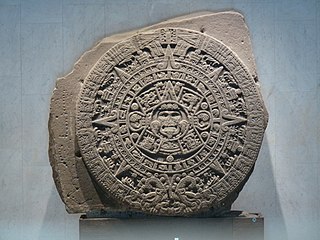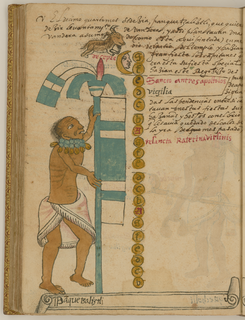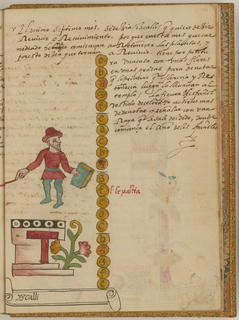Related Research Articles

The traditional Chinese calendar, is a lunisolar calendar which identifies years, months, and days according to astronomical phenomena. In China, it is defined by the Chinese national standard GB/T 33661–2017, "Calculation and Promulgation of the Chinese Calendar", issued by the Standardization Administration of China on May 12, 2017.

The Aztec or Mexica calendar is the calendrical system used by the Aztecs as well as other Pre-Columbian peoples of central Mexico. It is one of the Mesoamerican calendars, sharing the basic structure of calendars from throughout ancient Mesoamerica.

Śrāvaṇa is the fifth month of the Hindu calendar. In India's national civil calendar, Śrāvaṇa is the fifth month of the year, beginning on July 23 and ending on August 22. In the Tamil calendar, it is known as Āvani and is the fifth month of the solar year. In lunar religious calendars, Śrāvaṇa begins on the new moon or the full moon and is the fifth month of the year. Srabon is the fourth month of the solar Bengali calendar. It is also the fourth month of the Nepali calendar. Śrāvaṇa is also the second month of Varsha.
Sri Venkateswara Swami vari Brahmotsavam or Srivari Brahmotsavam is the most significant annual fête celebrated at the Venkateswara Temple in Tirumala-Tirupati, Tirupati district, Andhra Pradesh, India. The feast lasts for one month during the Hindu calendar month of Āśvina, which falls between the Gregorian calendar months of September and October.

Codex Ríos is an Italian translation and augmentation of a Spanish colonial-era manuscript, Codex Telleriano-Remensis, that is partially attributed to Pedro de los Ríos, a Dominican friar working in Oaxaca and Puebla between 1547 and 1562. The codex itself was likely written and drawn in Italy after 1566.
The Xiuhpōhualli is a 365-day calendar used by the Aztecs and other pre-Columbian Nahua peoples in central Mexico. It is composed of eighteen 20-day "months," called veintenas or mētztli with a separate 5-day period at the end of the year called the nemontemi. Whatever name that was used for these periods in pre-Columbian times is unknown. Through Spanish usage, the 20-day period of the Aztec calendar has become commonly known as a veintena. The Aztec word for moon is mētztli, and this word is today to describe these 20-day periods, although as the sixteenth-century missionary and early ethnographer, Diego Durán explained:
In ancient times the year was composed of eighteen months, and thus it was observed by these Indian people. Since their months were made of no more than twenty days, these were all the days contained in a month, because they were not guided by the moon but by the days; therefore, the year had eighteen months. The days of the year were counted twenty by twenty.

Festival of the Dead or Feast of Ancestors is held by many cultures throughout the world in honor or recognition of deceased members of the community, generally occurring after the harvest in August, September, October, or November.
Tozoztontli is the name of the third month of the Aztec calendar. It means Little Perforation. It is also a festival in the Aztec religion, the deities are Centeotl, Tlaloque, Chicomecoatl and Coatlicue. It marks the end of the dry season. It is the season of bird sacrifices and is called The Little Vigil.
Quecholli is the name of the fourteenth month of the Aztec calendar. It is also a festival in the Aztec religion and the Principal deity is Mixcoatl. It is called the Precious Feather and hunting is done during this season.
Hueymiccaihuitl, also called Xocotlhuetzi, is the name of the tenth month of the Aztec calendar. It is also a festival in the Aztec religion. The Principal deity is Xocotl. It is called Great Feast of the Dead.

Panquetzaliztli is the name of the fifteenth month of the Aztec calendar. It is also a festival in the Aztec religion dedicated to Huitzilopochtli. The correlation of Rafael Tena places the 20-day month last from November 30 to December 19.
Huey Tozoztli also known as Huey Tocoztli is the name of the fourth month of the Aztec calendar. It is also a festival in the Aztec religion dedicated to Tlaloc and other deities. It is called the great or long vigil.

Tecuilhuitontli is the name of the Seventh month of the Aztec calendar. It is also a festival in the Aztec religion. The principal deity is Xochipilli and feasts are also given to Goddess Huixtocihuatl and it is known as the Small Festival of the Lords.

Tepeilhuitl is the name of the thirteenth month of the Aztec calendar. It is also a festival in the Aztec religion dedicated to Popocatepetl, Iztaccihuatl and Tlaloc. It is called the festival or feast of the Mountains.

Teotleco is the name of the twelfth month of the Aztec calendar. It is also a festival in the Aztec religion and is known as the festival of All gods where all gods are worshiped.
Etzalcualiztli is the name of the sixth month of the Aztec calendar. It is also a festival in the Aztec religion dedicated to Tlaloc and Chalchihuitlicue.
Huey Tecuilhuitl also called Uey Tecuilhuitl is the name of the eighth month of the Aztec calendar. It is also a festival in the Aztec religion dedicated to Xilonen and Cihuacoatl. It is called the Great festival of the Lords.
Atemoztli is the sixteenth month of the Aztec calendar. It is also a festival in the Aztec religion dedicated to Tlaloc and Tlaloque.

Izcalli is the name of the eighteenth and last month of the Aztec calendar. It is also a festival in the Aztec religion, for which the principal deity is Xiuhtecuhtli the fire God. Old people are honored this month and it is known as Rebirth Month.
Nadaw is the ninth month of the traditional Burmese calendar.
References
- ↑ "Tlaxochimaco, the Ninth Month of the Aztec Solar Calendar". World Digital Library. Retrieved 21 July 2013.
- ↑ Mark G. Plew (1 January 1998). Explorations in American Archaeology: Essays in Honor of Wesley R. Hurt. University Press of America. pp. 75–. ISBN 978-0-7618-1184-8 . Retrieved 21 July 2013.
- ↑ "The Aztec Festivals". www.amoxtli.org. Archived from the original on 16 September 2015. Retrieved 24 July 2013.